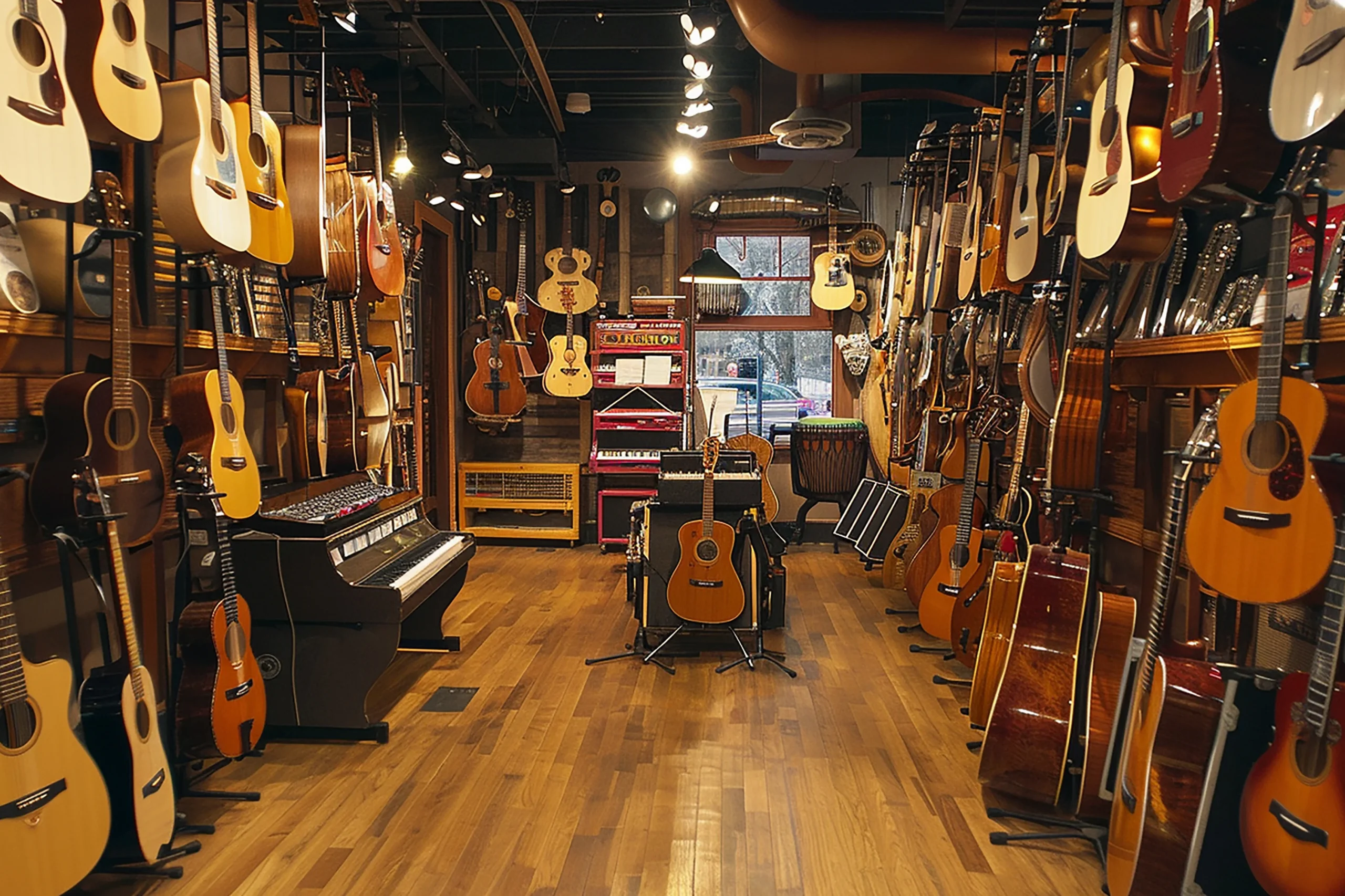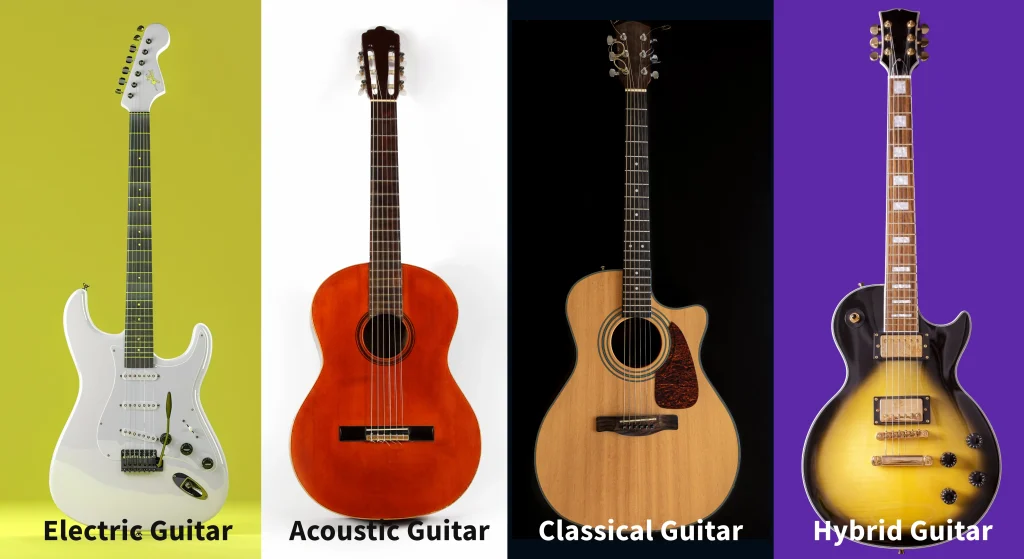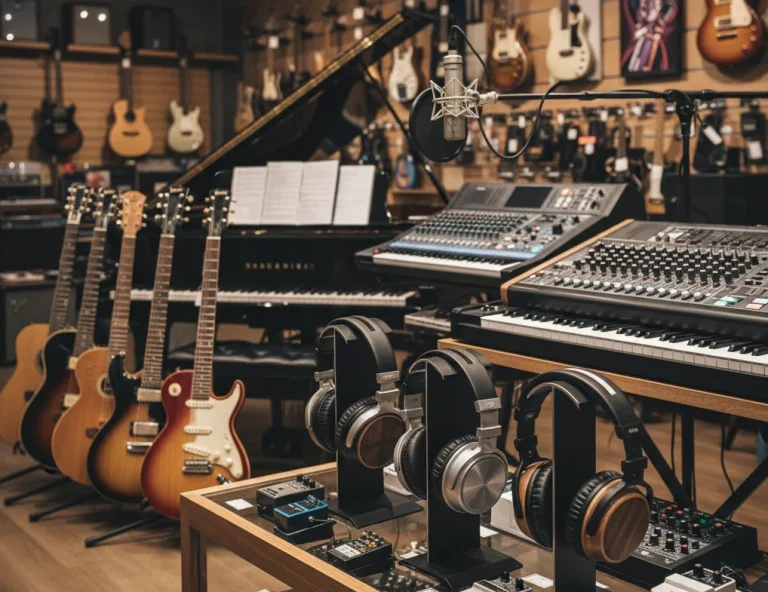All Topics
- Alchemizing Music Concepts for Students
- Artist Spotlight
- artium gift card
- Artium Maestros
- Artium News
- buying guide
- Carnatic Music
- Devotional Music
- Editorials by Ananth Vaidyanathan
- Film Music
- Guitar
- Hindustani Classical Music
- Indian Classical Music
- Indian Folk Music
- Insights
- Instruments
- Karaoke Singing
- Keyboard
- Kids Music
- maestros
- Music Education
- Music for Kids
- Music Industry
- Music Instruments
- Music Legends
- Music Theory
- Music Therapy
- Piano
- piano guide
- Success Stories
- Tamil Film Music
- Telugu Film Music
- Time Theory
- Tools
- Uncategorized
- Vocal Singing
- Vocals
- western classical music
- western music
- Western vocal music
A Complete Guide to Buying Your First Guitar
A Complete Guide to Buying Your First Guitar

Table of Contents
As an aspiring guitarist beginning their journey, choosing the right guitar can feel overwhelming. Finding the right instrument should not be stressful, whether you are a working professional picking up music as a hobby, a parent guiding your child towards musical dreams or a young musician ready to explore your passion. In this blog, we will guide you through the process of buying your first guitar, demystify the steps, and empower you to make an informed decision.
The best thing about learning guitar today is the accessibility to quality instruments. Whether you are looking for an electric guitar, acoustic guitar, or classical guitar, the market offers a range of options at various price points. When you buy a guitar online or visit a physical store, this comprehensive guide to buying your first guitar walks you through everything you need to know before making your purchase, ensuring that when you bring your first guitar home, you’re set up for success from day one.
Choosing the Right Guitar for Your Journey
The first question that arises in this journey is a simple yet profound one.
What type of guitar should you choose?

The answer to which totally depends on your musical goals, physical comfort, and the thing that excites you the most about the instrument. Let’s explore each option so you can make an informed decision. The importance of choosing based on inspiration cannot be overstated. Studies show that beginners who choose instruments that match their musical interests tend to remain committed longer and progress more quickly.
If rock music inspires you, an electric guitar might spark more enthusiasm than an acoustic. Conversely, if you dream of playing classical pieces or folk songs, an acoustic or classical guitar could be your perfect match.
1. Electric Guitar
The electric guitar is the top choice for beginners interested in rock, blues, pop and contemporary genres. The mechanism of the electric guitar is that sounds are produced through electromagnetic pickups, which convert string vibrations into electrical signals that are then amplified into the electric sound we know.
Why choose an electric guitar when learning?
- Easier on fingers due to lighter strings and thinner necks
- Availability of smaller body sizes, perfect for young players or those with smaller hands
- Various sound palettes, from clean to heavy distortion
- Popular in modern music genres, keeping learners motivated
Things to consider when buying
- Needs additional equipment like an amplifier, cables and headphones
- Higher initial investment for acoustic guitars
- Need regular maintenance and occasional professional setup
- Need amplification since sound is not projected acoustically
Beginner-friendly Guitar Brands in India
- Yamaha Pacifica
- Fender Squier
- Ibanez GRX
- Cort models
These guitars range between Rs. 8000 – Rs. 20,000. Understanding these options to buy a guitar online helps you compare features before making a purchase.
2. Acoustic Guitar
This is the most common choice of guitar among learners. They produce sounds naturally through their hollow wooden body and require no amplifiers for casual playing. Their bright, warm tones have inspired musicians across genres like folk, country, pop and even rock. It is versatile and exceptional for anyone learning to play the guitar.
From playing by a campfire to in your room or during intimate gatherings, you can play it anywhere. This accessibility translates into consistent practice and faster skill development. It’s a preferred choice among parents when they want to order guitar online due to simpler shipping and reduced equipment needs.
Why choose an acoustic guitar when learning?
- No extra equipment needed to get started
- Beautiful and complete sound, perfect for multiple genres
- Portable and perfect for practice anywhere
- Cost-effective compared to electric setups
- Steel strings to develop finger strength over time
Things to consider when buying
- Steel strings can be uncomfortable initially for tender fingers
- Larger body sizes might feel unwieldy for younger players
- Thicker necks require larger hands for comfortable chord playing
- Generally louder than classical guitars, which matters in shared spaces
Beginner-friendly Guitar Brands
- Yamaha F280
- Fender SA – 10
- Kadence Frontier series
Typically, these guitars are priced between Rs. 5,000 and Rs. 12,000. These models are specifically designed to meet the needs of beginners learning to play the guitar.
3. Classical Guitars
In this guide to buying your first guitar, these bring centuries-old musical traditions to the modern era. They have nylon strings, wider necks and smaller bodies than acoustic guitars. It creates a warm, mellow sound perfect for classical music, flamenco and fingerstyle playing.
Classical guitar can give you an ideal foundation for fingerpicking patterns, classical compositions or Spanish flamenco styles. The wider neck of the guitar allows for precise finger placement, making it suitable for complex techniques, while nylon strings are gentler on developing fingers. Many beginner guitar guides recommend classical guitar as an option for those prioritizing comfort.
Why choose classical guitar for learning?
- Easy on fingers due to nylon strings and lower string tension
- Wider neck spacing facilitates complex fingerpicking techniques
- Softer, warmer tone ideal for classical, flamenco and Latin music
- Perfect for developing finger independence and technique
- Beautiful aesthetic appeal that inspires regular practice
Potential challenges
- Limited use in rock, pop, or contemporary music
- Takes longer to develop volume and projection
- Wider necks can feel cramped for players with smaller hands
- Nylon strings require different playing techniques than steel strings
Quality beginner classical guitars in India start around ₹8,000, with brands like Yamaha and Cort offering excellent value across different budgets.
4. Hybrid Guitars
These guitars bridge the gap between classical and modern preferences. They combine the benefits of classical guitar’s nylon strings with narrow necks and body designs inspired by steel-string acoustic guitars. It is perfect for learners interested in the gentle playing experience of classical guitar, combined with the versatility of modern music styles. Students who play a range of music, from classical pieces to contemporary fingerstyle songs, will find that these guitars offer flexibility without compromising comfort or sound quality. When learning how to buy a guitar for diverse musical interests, hybrids present an excellent middle-ground option.
Comparing Guitar Types: Finding the Right One
Let us break down how these four main types of guitars compare across important factors:

Use the comparison guide above to determine which guitar is best suited for beginners to meet your needs.
What to Look for When Buying a Guitar?
Before you buy a guitar for kids, knowing what to inspect ensures you are getting a quality instrument. Follow this guide to buying your first guitar. Don’t skip this step, or you will end up with a guitar that sounds poor or feels uncomfortable, situations that often lead to abandoning the instrument altogether.
- Tuning stability: Should be your priority
Keeping your guitar in tune is essential. Get the store staff to tune the guitar and play a few chords. If the guitar has poor tuning, it means there’s a problem with the instrument, or it needs a professional setup. Having a guitar that’ll hold a tune turns practice sessions into joy and excitement. This has a far-reaching impact than you think, so when you buy a guitar online, verify that the tuning stability reviews consistently receive positive feedback.
- Neck straightness matters
Visually inspect the neck against a straight edge or look along its length toward a light source. A straight neck is essential for comfortable playing. Bows, twists, or significant curves create buzzing frets and uncomfortable playing positions. While a professional can address minor issues, starting with a straight neck eliminates one variable from your beginner journey.
- Action height
Action refers to how far the strings sit from the fretboard. Having high or low action can hamper the playing experience. Strings should sit about 2-3mm from the fretboard at the 12th fret. Run your finger along the frets to ensure they’re level and properly seated.
- Fretboard Accessibility
Your access to the entire fretboard should not strain you. The frets should feel level under your fingers. If the frets are higher or lower, then your guitar likely needs fret levelling. To avoid this expense, ensure you run a thorough check.
- Electronics and Switches (for electric guitars)
For electric guitars, ensure to plug it in and test all switches and knobs. Any crackling or cutting of sounds indicates that the electronics are dirty. The pickups should produce clear, consistent tones across all positions.
Selecting the Right Size and Fit
For young players, the size of the guitar is a significant consideration. An oversized guitar creates playing difficulties and discourages practice. Conversely, outgrowing your instrument quickly leads to upgrade costs. Understanding guitar sizing helps you make informed choices before committing to a purchase.
Guitar sizing chart by age and height

These are just guidelines, and it is essential to note that individual hand size and arm length vary. Let your child hold different sizes to find what feels comfortable. This hands-on approach consistently outperforms theoretical sizing.
Essential Accessories for Beginner Guitarists
Just like guitars, even their accessories are equally important. These accessories can transform your practice experience and protect your investment. When you buy a guitar online or in a store, having these accessories ensures a complete setup that supports successful learning and playing.
- Extra strings
- Guitar strap
- Gig bag or soft case
- Guitar picks
- Metronome
- Capo
In this article on a guide to buying your first guitar, you’ll find all the relevant information for choosing the right one. For electric guitars, you will need practice amps. Combo amps can also be a good option. It integrates the amp and speaker, and is beginner-friendly. Then, you need instrument cables to connect to the amp, and lastly, headphone adapters to let you practice silently through headphones.
Pre-Purchase Checklist: Your Buying Roadmap
Before visiting a store or clicking to order guitar online, confirm you’ve considered these essentials:
- Musical Genre – What music inspires you? Match your guitar to those styles.
- Physical Fit – Can you comfortably reach all frets and hold the instrument for extended periods?
- Budget Clarity – Include all accessories in your budget, not just the guitar.
- Quality Standards – Inspect the instrument for construction quality, finish condition, and durability of the hardware.
- Tuning Stability – The guitar remains in tune after it is tuned at the store.
- Sound Test – Does it sound pleasant to your ears? Does the tone inspire you?
- Playability – Action height and fret condition allow comfortable playing.
- Warranty Coverage – What Does the Manufacturer Guarantee? What do local sellers offer?
- Size Appropriateness – The guitar is sized appropriately for the player’s size and strength.
- Store Reputation – Buy from established music retailers with after-sales support.
Best Beginner Guitar in India
The Indian guitar market offers a range of options for purchasing a guitar online and through physical retailers. Here are some of the most popular choices among beginners:
- Yamaha
This is a reputed brand among beginners in India. Their acoustic models start between Rs. 8000 – Rs. 10,000. Their electric options start at Rs. 12,000 and go up to Rs. 18,000. Since it’s made in India, it ensures affordability without compromising on quality. Teachers consistently recommend Yamaha across music academies nationwide when parents ask about the best guitar brands for beginners in India.
- Fender Squier
This is a budget line guitar that brings legendary brand heritage to beginner prices. The Sonic Mustang electric costs Rs. 8,000- Rs. 12,000, and the SA-105 acoustic, priced at Rs. 9,500- Rs. 11,000, offers authentic Fender playability at affordable prices.
- Kadence and Henrix
Kadence and Henrix offer entry-level acoustics priced between Rs. 3,000 and Rs. 7,000. While not ideal for lifelong use, these serve students who are exploring the guitar before making a significant investment.
- Ibanez
Ibanez’s slim necks and contemporary designs appeal to rock and metal enthusiasts. Their budget lines (GRX, Rs. 10,000- 15,000) strike a balance between modern aesthetics and beginner-friendly playability.
Buying a New Vs. Used Guitar
This guide to buying your first guitar explains that the difference between new and used can significantly impact your budget and long-term satisfaction. It is better to understand the trade-offs when choosing your guitar wisely.
Benefits of Buying a New Guitar
Buying a new instrument comes with a manufacturer’s warranty (usually 1 – 2 years) protecting against any defects. Since it is a new instrument, you are aware of the complete history, ensuring proper storage and care. Since you are buying a new guitar, it will require minimal setup compared to used instruments.
For beginners, particularly those who are motivated and committed, new guitars provide peace of mind and optimal playing experiences from the start. In India’s market, new beginner instruments at Rs. 8,000- Rs. 15,000 provide excellent value compared to their used equivalents.
Benefits of Buying a Used Guitar
A used guitar usually costs less, often 30-50% below retail. If you are unsure about long-term commitment, used instruments minimize financial risk. Quality vintage guitars age beautifully and sound better over time, a significant benefit when purchasing from reputable sellers.
Used Guitar Inspection Guidelines
- Carefully inspect the finish. While surface scratches can be easily taken care of, deep gouges often indicate neglect. Inspect the wood around the sound hole and headstock for cracks, as they may require expensive repairs.
- Test playability thoroughly. It doesn’t matter if the guitar sounds good; high action or uneven frets signal a need for a setup. Bring someone experienced to evaluate if possible, or request a professional pre-purchase inspection.
- Test tuning stability. A used guitar that refuses to stay in tune might need a nut replacement or neck adjustment, which can add to the cost.
- Check hardware condition. Corroded tuning pegs, damaged bridges, or worn frets indicate extensive use. These aren’t deal-breakers, but they do influence pricing.
- Get a trial period if possible. Many sellers offer return windows. Use this time to confirm the guitar that suits your needs.
Where to Buy Your Guitar?

The place from which you purchase your guitar influences your experience and the available support. Here are some options for purchasing a guitar.
Artium store
At Artium Academy, we believe every musician deserves access to the best quality instruments evaluated by industry experts. Our collection features curated instruments from guitars, keyboards and more that are personally recommended by master musicians and our faculty.
Each instrument is of the highest quality standards and is selected based on real teaching experience, ensuring the learner invests in an instrument that inspires consistent practice and aids in musical growth. When you buy through the Artium store, you’re not just purchasing an instrument; you are gaining access to a community of expert musicians ready to guide your learning journey through our structured online courses and weekly performance showcases.
Physical music stores
Music stores remain the most popular choice among first-time purchasers. You can hold instruments, hear various models and get expert guidance. Store staff can help to check your needs and often adjust guitars before sale. In India, cities like Mumbai, Delhi, Bangalore and Pune host excellent music retailers. The advantages of buying from stores include trying before buying, quick troubleshooting if problems arise and personal relationships with expert staff. Many stores offer service, provide setup and recommend teachers.
Online platform and E-commerce
Buying online has become an increasingly popular and viable option in recent years. Platforms like Amazon, Bajaao, etc offer extensive selections, customer reviews and competitive pricing. However, it still requires you to evaluate your purchase carefully since you can’t physically inspect them. Keep one thing in mind: if you want to buy a guitar in India, conduct thorough research. Read reviews, compare models and check return policies.
You can also check the Artium store to get curated instrument suggestions. These instruments are selected and recommended by the top musicians from around the world who teach at Artium. Through years of teaching students, these instruments are personally recommended by experts from Artium Academy and are suitable for everyone, from beginners to professionals. Their guidance will help you make an informed decision and choose the right instrument.
Starting Your Musical Education
Buying the right guitar is half the journey; quality instruction shapes your learning trajectory. While many resources exist, structured guidance accelerates progress and prevents discouraging plateaus.
Artium Academy’s online guitar courses represent a comprehensive learning pathway. Curated by renowned Bollywood music composer Raju Singh, these courses span beginner through advanced levels. Online guitar classes at Artium span four structured progressions, Preparatory, Intermediate, Proficient, and Advanced, to ensure students develop systematically rather than haphazardly.
Live online guitar classes for kids and adults provide personalized feedback, immediate problem-solving, and motivation that recorded tutorials lack. Performance opportunities, such as our weekly showcases and the annual Artium Superstar talent event, transform learning from solitary practice into a communal celebration.
Your Guitar Buying Journey Begins
Standing at the beginning of your musical journey, remember that the perfect first guitar inspires daily practice and fits your physical dimensions comfortably. Whether you choose electric, acoustic, classical, or hybrid and whether you purchase new, used, online, or in-store, the right decision balances your musical goals with practical considerations.
The guitar market today offers the best quality and accessibility across all price points. Instruments that would have cost Rs. 30,000-40,000 ten years ago now sell for Rs. 10,000-15,000, offering superior construction and sound quality. This democratization of music means anyone genuinely passionate about guitar can start their journey affordably.
At Artium Academy, we stand ready to guide you in this learning journey once your instrument arrives. With expert instruction from industry professionals and a community of aspiring musicians worldwide, your first guitar marks the beginning of a lifelong musical adventure. Whether you’re purchasing for yourself, your child, or as a gift, trust that the right choice combines quality, appropriate sizing, and genuine inspiration.
Take that first step. Your musical journey awaits, and with the knowledge from this complete guide to buying your first guitar, you’re now equipped to choose the guitar that’s perfect for you.
FAQs
The first thing to do is to check for tuning stability. Ask the attendant to tune and play a few chords to ensure it consistently holds the pitch. Check for the straightness of the neck, whether bows/twists create buzzing and discomfort. Check for action; ideally, your strings should sit 2-3mm from the fretboard at the 12th fret. For the electric guitar, test all switches, knobs & pickups for clear, consistent tones. Check for construction quality, finish condition and hardware durability. Most importantly, ensure the guitar size matches your height and arm length, and that the sound inspires you personally.
The first thing to identify before buying a guitar for beginners is musical goals, genre inspiration and physical comfort. The second factor is the budget. For beginners, quality instruments range from Rs. 5000 and Rs. 15000 for brands like Yamaha, Fender Squier, Kadence and Ibanez. Ensure the size is correct, especially if buying for children. Finally, invest in structured learning through quality instruction to accelerate progress and maintain motivation throughout your musical journey.
Buying a guitar online requires proper research. Start by reading the customer reviews. See what users have to say about tuning stability, build quality and playability. Compare multiple models on multiple websites within your budget. Specialized stores, such as Artium stores, offer instruments recommended by master musicians based on their real-world teaching experience. Check for return policies and warranty coverage; established sellers provide 7-15 day return windows. Watch video demonstrations to hear the instrument’s sound character. Verify the seller’s reputation and the availability of after-sales support. Consider buying from curated collections at the Artium store, where you will find expert-recommended instruments suitable for beginners through professionals, ensuring the best standards.
Start by defining your musical preferences and matching the guitar type to your favorite genre. Research for beginner-friendly brands like Yamaha, Fender Squier and Ibanez through customer reviews focusing on stability and playability. Compare neck width, string type, body size, warranty coverage and return policies.
A 12-string guitar features six pairs of strings tuned in unison or an octave apart, creating a fuller, shimmering sound popular in folk, rock, and country music. The doubled strings produce a harmonically complex tone ideal for adding texture and depth to recordings and performances. However, they require more finger strength due to increased string tension and aren’t recommended for absolute beginners. Once you’ve developed solid technique on a standard 6-string guitar, transitioning to a 12-string opens creative possibilities with its distinctive, ethereal sound character.
Essential accessories include extra strings, guitar picks, a tuner, a gig bag or soft case, a comfortable strap, and a capo. For electric guitars, add a practice amplifier, instrument cables, and headphone adapters for silent practice. A metronome develops timing precision. Optional additions include a guitar stand, string winder, and cleaning cloth. These accessories ensure a complete setup supporting successful learning from day one.
The best choice depends on your musical inspiration and physical comfort. Electric guitars have lighter strings and thinner necks, which are easier on developing fingers, but require amplifier equipment and a higher initial investment. Acoustic guitars produce complete sound without amplification, are portable and cost-effective, but steel strings feel uncomfortable initially and larger bodies suit bigger players. Studies show that beginners who choose instruments matching their musical interests remain committed longer and progress faster. Choose based on what excites you most, ensuring the instrument inspires consistent daily practice.
Match guitar size to age and height: ½ size (ages 3-6, under 3’8″), ¾ size (ages 6-9, 3’8″-4’6″), and full-size (ages 9+, over 4’6″). Classical guitars with nylon strings are suitable for beginners aged 6 and above due to their gentler strings and lower tension. Acoustic guitars with steel strings are suitable for children aged 8 and above as they develop finger strength. Electric guitars are suitable for children aged 7 and above, inspired by rock and modern music, offering lighter strings and smaller body options. Let your child try on different sizes to find what feels comfortable before making a purchase.




